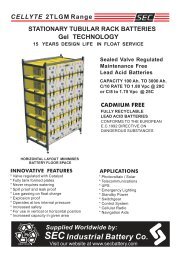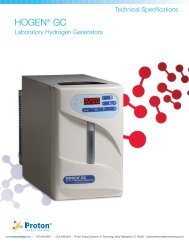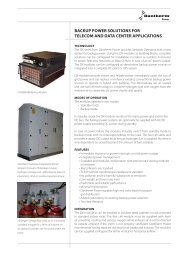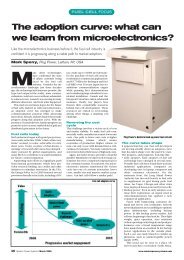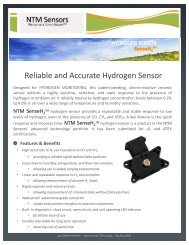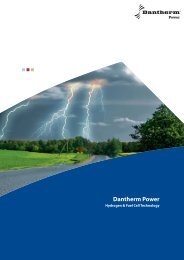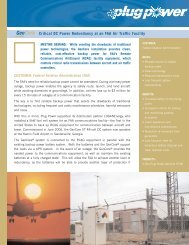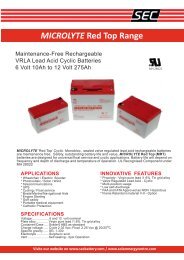SOFC Stack Modules for Decentralized Power ... - Fuel Cell Markets
SOFC Stack Modules for Decentralized Power ... - Fuel Cell Markets
SOFC Stack Modules for Decentralized Power ... - Fuel Cell Markets
Create successful ePaper yourself
Turn your PDF publications into a flip-book with our unique Google optimized e-Paper software.
<strong>SOFC</strong> <strong>Stack</strong> <strong>Modules</strong> <strong>for</strong> <strong>Decentralized</strong> <strong>Power</strong> Generation
Your Heart of Energy<br />
Customers around the world are demanding<br />
services at lower cost and with less environmental<br />
impact. Electricity generation based<br />
on high efficiency solid oxide fuel cells<br />
(<strong>SOFC</strong>) is best able to meet this need.<br />
The main barrier to market entry has been,<br />
until now, the supply of a robust and stable<br />
<strong>SOFC</strong> stack.<br />
staxera has solved this problem and now<br />
offers its integrated stack module (ISM) in<br />
volume and at low cost. The ISM is the heart<br />
of any <strong>SOFC</strong> energy conversion system.<br />
This product provides staxera’s customers<br />
with the opportunity to develop <strong>SOFC</strong> systems<br />
and then to enter and dominate the<br />
market <strong>for</strong> decentralized power generation.<br />
staxera is the world leading supplier of solid<br />
oxide fuel cells <strong>for</strong> <strong>SOFC</strong> systems – the only<br />
supplier with the staxera advantage.
2<br />
Ready to deliver<br />
staxera’s <strong>SOFC</strong> integrated stack modules (ISMs) are available immediately in<br />
volumes of up to 500 units per year. Standardized ISMs can be supplied <strong>for</strong><br />
initial system development and customized ISMs can be developed to allow even<br />
tighter system integration. High volume manufacture (up to 50.000 units per<br />
year) is possible within two years, allowing <strong>for</strong> the construction of a new manufacturing<br />
hall, installation of automated assembly equipment, and commissioning.<br />
Security of supply<br />
n active in more than 58 countries<br />
n automobile component supplier<br />
n 1.6 billion € turnover in 2008<br />
n 7.5% investment of turnover in R&D<br />
n more than 7000 employees<br />
staxera GmbH is stably and securely held by Webasto AG, a German family<br />
owned company and one of the world’s 100 largest automobile component<br />
suppliers.<br />
staxera was previously a 50:50 joint venture between We-<br />
basto AG and H.C. Starck. Webasto AG obtained full<br />
control of staxera by purchasing H.C. Starck’s<br />
50% shareholding in late 2009. H.C. Starck<br />
remains staxera’s cell supplier and development<br />
partner. Webasto AG and staxera<br />
GmbH are committed to the long term<br />
development of <strong>SOFC</strong> as a key component<br />
in the world’s clean tech future.<br />
3
4<br />
Mk200 <strong>SOFC</strong> stack<br />
The staxera Mk200 stack was developed using a top-down design process based<br />
on clear system requirements <strong>for</strong> low cost, low pressure drop and robust operation.<br />
Stamped sheet metal interconnects provide low cost while ESC cells provide thermal<br />
and redox stability.<br />
The stack is compatible with a wide variety of fuel<br />
gases, including CPOX and steam re<strong>for</strong>ming. Air<br />
flow can be either co-flow or counter-flow, simply by<br />
selecting which side to use as the air inlet.<br />
staxera has developed a deep understanding of the<br />
temperature gradients and thermomechanics occuring<br />
within the Mk200 stack. This enables us to optimize<br />
the design and deliver world-class robustness<br />
and endurance.<br />
Low anode and cathode pressure drops help to minimize<br />
system parasitic losses, while an open cathode<br />
allows tight system integration if desired.<br />
5
Integrated stack module (ISM)<br />
The staxera ISM provides the critical functional en-<br />
vironment <strong>for</strong> the <strong>SOFC</strong> stack, thereby allowing<br />
rapid system integration and robust per<strong>for</strong>mance.<br />
Clearly defined interfaces <strong>for</strong> gases, sensors and<br />
electrical current are provided, as well as components<br />
<strong>for</strong> compression loading, thermal insulation,<br />
cathode manifolding; and pressure, voltage and<br />
temperature measurement.<br />
Using this approach staxera guarantees 5.000 hours<br />
of operation and 20 thermal cycles when the ISM is<br />
operated within pre-defined parameters.<br />
The ISM is presently available with a rated power of<br />
1.1 kW at a fuel utilization of 75%. Future ISMs will<br />
have increased power, reduced heat loss, and higher<br />
limits <strong>for</strong> fuel utilization.<br />
7
8<br />
Your heart of energy<br />
staxera delivers ISMs worldwide to a large variety of industrial customers,<br />
supporting individual requirements whilst maintaining complete confidentiality.<br />
The ISM <strong>for</strong>ms the heart of each customer's energy conversion system.<br />
Several of staxera’s customers are shown here.<br />
EBZ GmbH has developed a 3 kW system demonstrator based on<br />
steam re<strong>for</strong>ming of natural gas. This system can be modified to suit<br />
a range of fuels such as biogas and landfill gas; and is also capable<br />
of acting as a combined heat and power (CHP) system. The system<br />
is available <strong>for</strong> purchase – please contact www.ebz-dresden.de <strong>for</strong> further details.<br />
Vaillant GmbH is one of<br />
Europe’s largest manufacturers<br />
of heating, ventilation and air conditioning<br />
systems. Vaillant is developing a 1 kW microCHP<br />
system <strong>for</strong> single family houses. Vaillant selected the<br />
staxera <strong>SOFC</strong> as it's basis <strong>for</strong> a microCHP system<br />
over competing technologies such as stirling engines,<br />
PEM fuel cells and internal combustion engines.<br />
Callux is Germany’s big-<br />
www.callux.net<br />
gest practical test project<br />
<strong>for</strong> small residential fuel cell based heating systems.<br />
As part of the National Innovation Program <strong>for</strong> Hydrogen<br />
and <strong>Fuel</strong> <strong>Cell</strong> Technology (NIP), industry and<br />
government are together investing 1 billion € to<br />
promote this innovative concept. More than 50 fuel<br />
cell heaters are already up and running, and by the<br />
end of 2012 some 800 units will undergo trials.<br />
A significant number of these units will be constructed<br />
by Vaillant using ISMs from staxera.<br />
Continuous improvement<br />
staxera has been developing <strong>SOFC</strong> stacks since the company was founded in<br />
2005. Products have been sold on the open market since 2006, when the<br />
Mk100 stack was first introduced. Each year thereafter has seen continuous<br />
improvement in staxera’s products, including the higher power Mk200 stack in<br />
2007 and the integrated stack module (ISM) in 2008.<br />
The ISM is now staxera’s main product, owing to its defined interfaces and ease<br />
of use. Since 2009 staxera’s has supplied large customers with customized<br />
ISM designs, according their individual requirements.<br />
2006 2007 2008 2010<br />
Year Company improvement<br />
2005 Company founded<br />
2006 Mk100 stack, 350 W<br />
2007 Mk200 stack, 500 W<br />
2008 Integrated stack module (ISM), 1 kW<br />
2009 ISM 1.1 kW, customer specific solutions<br />
2010 ISM 1.4 kW<br />
2011 ISM 1.7 kW<br />
2012 ISM 3 kW<br />
2013 ISM 5 kW<br />
9
10<br />
11
12<br />
staxera advantage<br />
<strong>SOFC</strong> system developers can save time and reduce cost and risk by sourcing ISMs from staxera. This<br />
produces the best possible business case <strong>for</strong> the <strong>SOFC</strong> developer – the staxera advantage.<br />
Time to market<br />
The ISM is available immediately in volumes of up to 500 units per year. Standardized ISMs can be supplied<br />
<strong>for</strong> initial system development, and customized ISMs can be developed to allow even tighter system integration.<br />
High volume manufacture (up to 50.000 units per year) is possible within two years, allowing <strong>for</strong><br />
the construction of a new manufacturing hall.<br />
Development cost and production cost<br />
Sourcing ISMs from staxera is cheaper than either developing a new <strong>SOFC</strong> stack design or manufacturing<br />
at a separate facility. staxera has already developed the stack, together with a family of proprietary and pa-<br />
tented production processes. <strong>SOFC</strong> production costs are strongly dependent upon production volume,<br />
and our customers benefit from staxera’s quantity of scale. In series production the profit margins from<br />
staxera will be comparable with suppliers from the automotive industry.<br />
Backup by broad R&D support<br />
staxera’s technical results are backed by a multi-year joint research program between the Fraunhofer IKTS<br />
and staxera. IKTS is investigating the degradation mechanisms of interconnector steels, contact elements<br />
and sealing glasses, and the results of this work will lead to a new generation of materials and there<strong>for</strong>e to<br />
improved stack per<strong>for</strong>mance. This deep understanding of failure mechanisms substantially reduces our customer’s<br />
long term development risk.<br />
Technical risk<br />
The optimum per<strong>for</strong>mance of <strong>SOFC</strong> stacks in a system environment requires specific stack characteristics.<br />
These are not obvious if you start with a bottom up stack development program from cells to stacks.<br />
staxera has manufactured and tested hundreds of stacks; has conducted an initial HAZOP analysis; and<br />
has improved the design accordingly.<br />
staxera’s expertise is <strong>SOFC</strong> stack engineering de-<br />
sign and manufacture, focussing on thermomechanics,<br />
tolerances and scale up.<br />
Fraunhofer IKTS is staxera’s R&D partner, focus-<br />
sing on materials science, sealing glasses, contact<br />
pastes and protective coatings.<br />
H.C. Starck is staxera’s cell, paste, and glass sup-<br />
plier; with a manufacturing capacity of 3 million cells<br />
per year.<br />
ThyssenKrupp VDM is staxera’s supplier <strong>for</strong> high<br />
temperature ferritic sheet steel, optimized <strong>for</strong> <strong>SOFC</strong><br />
operation.<br />
13
14<br />
Technical per<strong>for</strong>mance<br />
ISMs from staxera have excellent technical per<strong>for</strong>mance in the critical areas of power, thermal cycling,<br />
lifetime and redox stability. These parameters are absolutely crucial <strong>for</strong> successful system per<strong>for</strong>mance.<br />
<strong>Power</strong><br />
The staxera <strong>SOFC</strong> stack delivers both high power and high efficiency, owing to<br />
it’s capacity to operate at 75% fuel utilization.<br />
Thermal cycling<br />
staxera has demonstrated 150 thermal cycles with a 30-cell Mk200 stack, and<br />
50 thermal cycles with a ISM. This is world class per<strong>for</strong>mance.<br />
Lifetime<br />
staxera has demonstrated over 10.000 hours of stable operation on both the older<br />
Mk100 and the present Mk200 stack designs, with degradation less than 0.4%<br />
per 1.000 hours. Commercial targets are between 40.000 and 80.000 hours.<br />
Redox stability<br />
ESCs have excellent redox stability as the anode (which expands and contracts<br />
as it oxidizes and reduces) is very thin, and is supported by the thicker electrolyte.<br />
The power delivered by a staxera ISM is dependent upon the fuel composition, fuel utilization and the<br />
operating temperature. To improve our customer service staxera has selected one reference operating<br />
condition which all organizations can reproduce:<br />
n fuel composition of 40% hydrogen and 60% nitrogen<br />
n fuel utilization of 75%<br />
n operating temperature 850°C<br />
The diagram above shows the power as a function of current at the reference operating condition, and<br />
also at two other typical gas compositions.<br />
15
16<br />
<strong>SOFC</strong> stacks must be able to operate reliably and stably over a long period of time. For typical<br />
applications such as microCHP or decentralized power generation, our customers require a lifetime<br />
of at least 40.000 hours, with some customers requiring 80.000 hours. The degradation<br />
over this time period must usually be less than 0.5% per 1.000 hours.<br />
staxera has conducted endurance tests of over 10.000 hours with both the older Mk100 stack design<br />
and the present Mk200 stack design. The diagram above shows that the total stack degradation after<br />
12.000 hours is less than 4%, which translates to less than 0.4% per 1.000 hours.<br />
Since this data was collected staxera has improved the cycling capability of the Mk200 stack, which<br />
should prevent sharp changes in degradation as observed at 7.500 hours above. Until this time, the<br />
stack had a total degradation of less than 0.1% per 1.000 hours.<br />
<strong>SOFC</strong> stacks must be able to turn on and off with the <strong>SOFC</strong> system. This is called thermal cycling,<br />
and the number of cycles required is dependent upon each customer and each system application. The<br />
diagram above shows that the Mk200 stack can survive over 160 complete power and thermal cycles.<br />
The stack cycles between 850°C and 100°C, and also between full load (22 A) and no load. This is<br />
world class per<strong>for</strong>mance.<br />
17
18<br />
3 kW system demonstrator<br />
The 3 kW system demonstrator is a product from the<br />
company EBZ GmbH, which is also located in Dresden,<br />
Germany. EBZ and staxera cooperated on the<br />
development of this system.<br />
The system was developed to show that the staxera<br />
ISM can operate reliably and efficienctly when fuelled<br />
with steam re<strong>for</strong>mate, particularly with internal re<strong>for</strong>ming.<br />
Secondly, the system is intended as the first<br />
step towards 20 kW systems <strong>for</strong> decentralized electricity<br />
generation.<br />
The 3 kW system demonstrator is designed <strong>for</strong> a peak<br />
stack power of 3 kW, using two staxera ISMs, each<br />
with a peak power of up to 1.5 kW. At present the<br />
system is operating with two 1.1 kW ISMs. Future<br />
systems will have a power output of 5 kW and then<br />
20 kW. staxera and EBZ are seeking an industrial<br />
partner <strong>for</strong> this project.<br />
The 3 kW system demonstrator is the ideal plat<strong>for</strong>m <strong>for</strong> <strong>SOFC</strong> system research<br />
and development. Control strategies can be adjusted and some components<br />
(such as ISM, blowers) can be exchanged.<br />
Customized solutions<br />
The system is able to be modified to suit each customer’s individual requirements.<br />
For example, <strong>for</strong> operation with biogas or LPG, or with power levels from<br />
1 to 5 kW. For more details please contact EBZ directly: www.ebz-dresden.de<br />
19
Your Heart of Energy<br />
staxera is committed to supplying the highest<br />
quality <strong>SOFC</strong> stacks in the world, with excellent<br />
customer service. Please do not hesitate<br />
to contact us <strong>for</strong> further in<strong>for</strong>mation.<br />
staxera GmbH 2010<br />
staxera GmbH<br />
Gasanstaltstraße 2<br />
01237 Dresden . Germany<br />
phone: +49-351-896797-0<br />
fax: +49-351-896797-831<br />
info@staxera.de<br />
www.staxera.de
staxera GmbH | Gasanstaltstraße 2 | 01237 Dresden . Germany | phone: +49-351-896797-0 | www.staxera.de




